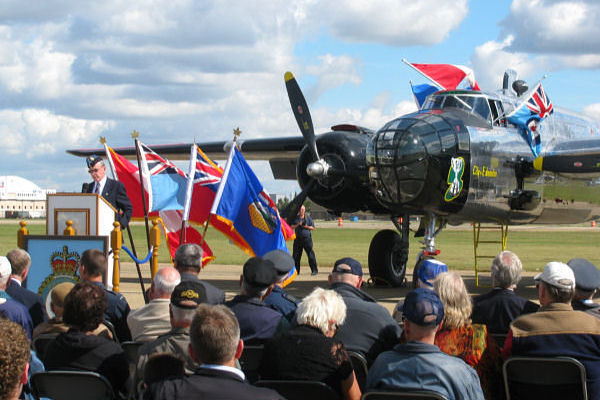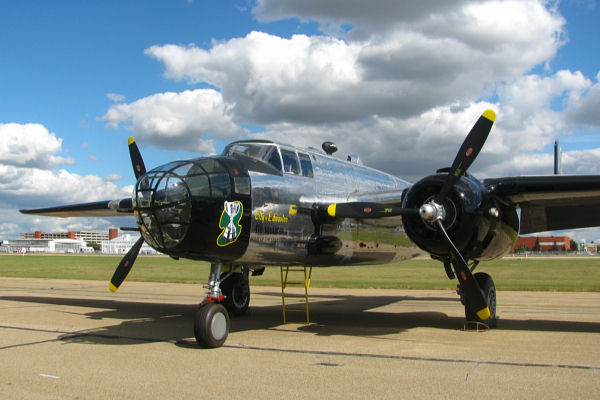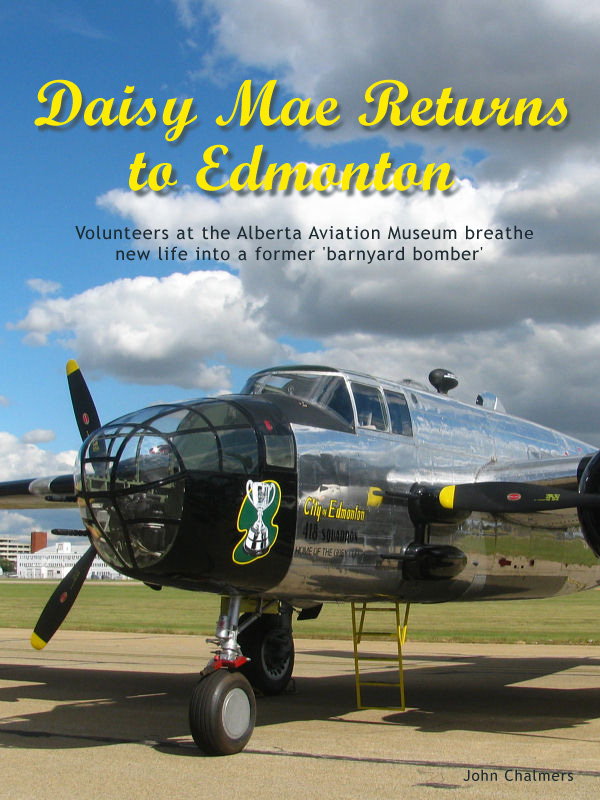

What do De Havilland Mosquito fighter-bombers have in common with North American B-25 Mitchell bombers, other than both being twin-engine warbirds? If they flew with RCAF 418 City of
Edmonton Squadron, it was nose art they shared of characters from the L'il Abner comic strip.
During the Second World War, RCAF 418 Squadron obtained permission from Al Capp, creator of L'il Abner, to put his characters on Mosquito fighter-bombers flown by the squadron.
Post-war, when the Squadron flew Mitchell bombers from the wartime hangar that is now home to the Alberta Aviation Museum, the tradition continued.
Written and drawn by cartoonist Al Capp (1909-1979), L'il Abner ran for 43 years, from 1934 to 1977 and ended with Capp's death. Since then, two generations have been born who have
never read about L'il Abner Yokum, but the characters from his town of Dogpatch are remembered by the 418 City of Edmonton Squadron Association and by the Alberta Aviation Museum in
Edmonton.
The museum's restored Mosquito bears the likeness of Hairless Joe as nose art on the port side. With his partner, Lonesome Polecat, the Dogpatch duo brewed up their potent moonshine,
Kickapoo Joy Juice. The Mosquito is painted in the colours of one flown by Russell Bannock DSO, DFC, and the paint job includes the symbols of the enemy aircraft and V-1 rockets he shot down.
After the Second World War, the 418 Squadron Foundation (now the 418 Squadron Association) was formed in 1985 with the intention of raising funds to restore a De Havilland Mosquito of the
type flown by the Squadron, with which 418 became the highest scoring RCAF fighter squadron of the War. A Mosquito flown after the war by Spartan Air Services was acquired and shipped to
Edmonton and restored for display. Damage incurred en route necessitated repairs as soon as it arrived before it could be put on display.
As Association president LCol. (Ret.) Jim Gillespie has written, "We accomplished our first objective not once, but twice. The second restoration of the same aircraft became necessary when
the refurbished 'wooden wonder' deteriorated badly while doing sentry duty at the main gate of CFB Namao, north of Edmonton. This latest factory-quality rebuild was completed in 1995." The
restored Mosquito is now proudly displayed at the Alberta Aviation Museum, 11410 Kingsway Avenue, Edmonton.
On September 3, 2011, 418 Squadron Association rolled out a restored B-25 Mitchell, its shiny fuselage looking like new. At roll-out, the bomber was handed over to the Museum. The project
took eight years, starting with a partial hulk of an aircraft fuselage recovered from a farm near Edmonton. With the skilled work of over 40 volunteers who invested 43,000 hours, plus more
than $200,000 raised by the Association, the bomber was ready for its public debut.
Featured on the starboard side is the nose art portrayal of the beautiful and buxom Daisy Mae, the love of L'il Abner's life, and eventually his wife. Just as one of the Mitchells flown by
418 Squadron after the war bore Daisy Mae's likeness, both the nose art and the call letters, HO 251, replicate a bomber flown by the Squadron in the 1950s. Featured on the port side of the
restored bomber is the Grey Cup, an exact reproduction of the nose art that paid tribute to the championship victories of the Edmonton Eskimos in the Canadian Football League during the
1950s.
While it is not possible to recognize all volunteers whose labour is evident in the restored Mitchell, at the risk of not naming many, at least some deserve mention. Long-time volunteer
Chuck MacLaren, now 94, did much of the work in restoring the wings, which arrived in rough shape five years ago from a boneyard in California. Sgt. (Ret.) Ed Doucette, a career airman who
worked on the project from the beginning, had the honour of driving the mule to tow the Mitchell out for its first public appearance. Volunteers like Chuck and Ed along, with many others,
brought their skills to work in jobs such restoration of the fuselage and wings, installation of new Plexiglas, installing the engines, painting where necessary, and applying RCAF insignia.
Dan Baines of Drayton Valley, Alberta flew his own aircraft into Edmonton City Centre Airport, where the museum is located, to work on the Mitchell. Ken Heiberg, a trucker from Regina, often
passed through Edmonton on his route and stayed over to work on the restoration. "He worked his heart out," says restoration manager Lindsay Deeprose, "and did all sorts of jobs on the
Mitchell, including some of the roughest and dirtiest." Deeprose himself has been a volunteer at the museum for 23 years, working on many of the aircraft restoration projects. Artist Mark
McAthey, created not only the Grey Cup nose art true to the original, he did justice to painting the pure-of-heart Dogpatch beauty, Daisy Mae. Al Capp would be pleased.
Like the Mosquito, the B-25 Mitchell is more than a tribute to both wartime and post-war service of RCAF City of Edmonton Squadron. Both aircraft show what skilled and dedicated volunteers
at the Alberta Aviation Museum can do in restoration and preservation of aircraft that are important to Canada's aviation history and heritage. RCAF 418 Squadron operated from 1941 to 1994.
Its distinguished history is kept alive by the aircraft and through a dedicated display room and archives at the Alberta Aviation Museum. Although both the Mosquito and the Mitchell are on
static display and will not fly again, their future is secure as splendid artifacts and reminders of the service given by the Royal Canadian Air Force.
(John is a member of the board of directors of the Alberta Aviation Museum Association and Historian for Canada's Aviation Hall of Fame)
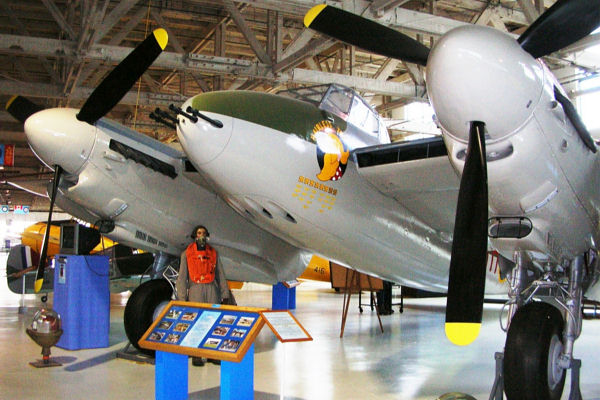
At the centre of the Alberta Aviation Museum collection is their De Havilland Mosquito. Built as a B.35 bomber, VP189 came to Canada as part of Spartan Air Services and registered CF-HMQ.
During its second restoration it was converted to resemble an FB.VI flown by 418 Squadron. (John Chalmers)
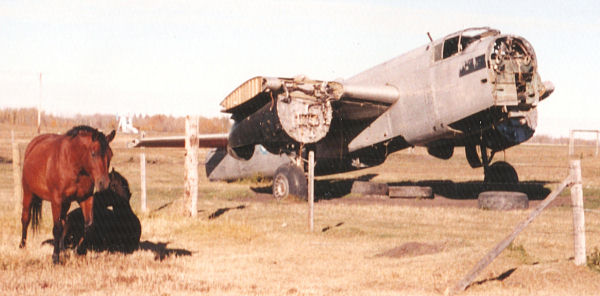
For years the museum's B-25 sat derelict in a farm near St. Albert before 418 Squadron Association acquired her and prepared her for restoration. Although the fuselage of SV273 was largely
intact, the wings, engines and propellers had been taken as spare parts to keep a fleet of fire bombers flying. A large hole had been cut out of the side of the mid-fuselage when another
organization needed the unique gun placement for their own B-25. Al Roberts captured this photo in October 2001, shortly before it was moved. (Al Roberts via 418 Squadron Association)
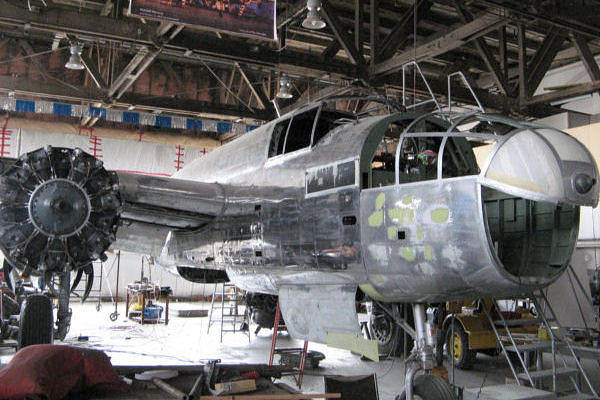
For 10 years, the Mitchell bomber occupied a large portion of the Alberta Aviation Museum's restoration shops. Being able to see the ongoing progress of an airplane as it was being
transformed from junk to jewel was a major attraction for many museum visitors. (John Chalmers)
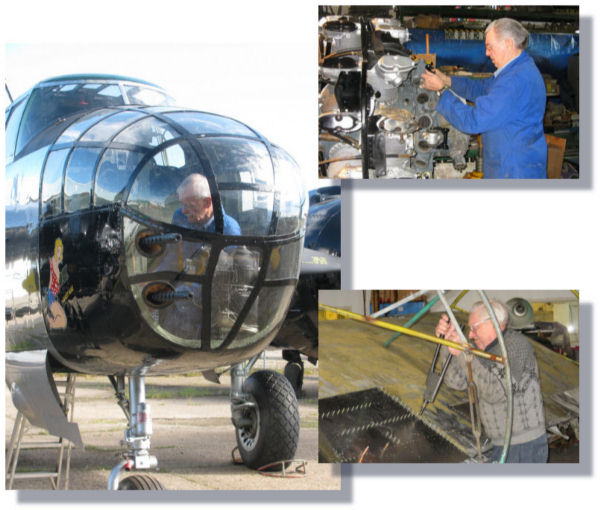
It's the volunteers that give any museum its heart. Their hard work and dedication invested to connect visitors with the past. Dan Baines (centre) works on the guns just prior to roll-out.
Ed Doucette (upper right) worked on one of the Mitchell's two 14-cylinder Wright Cyclone R-2600 radial engines that weigh nearly 2,000 pounds each. Chuck MacLaren (lower right) worked on
the Mitchell's wings, mounted on "rotisseries" so they could be rotated for work on either side. (John Chalmers)
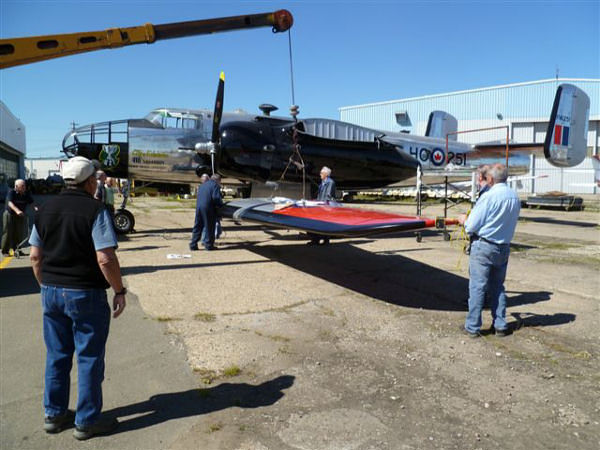
News reporter Thomas Dias captured the landmark step of mating the Mitchell's wings to the fuselage. Again, the volunteers turned out in force to accomplish this important milestone.
(Thomas Roy Dias, iNews880.com)
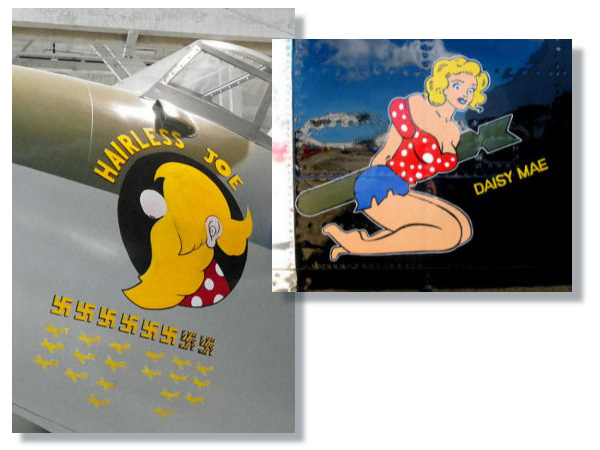
Al Capp's L'il Abner comic strip ran for more than four decades. With Capp's permission, the population of Dogpatch adorned 418 Squadron's Mosquitoes during the Second World War and
continued onto the squadron's B-25 Mitchells in the 1950s. Hairless Joe on the AAM's Mosquito (left) was originally flown by the legendary Russell Bannock DSO, DFC. In 1946 Bannock joined De
Havilland Canada as Chief Test Pilot and made the first flight of the DHC-2 Beaver. When it came to picking a representative Mitchell for museum's example, the attractive and ever faithful
Daisy Mae (inset) fit the bill. Besides, the original Daisy Mae had an mistakable connection to the museum... (John Chalmers)
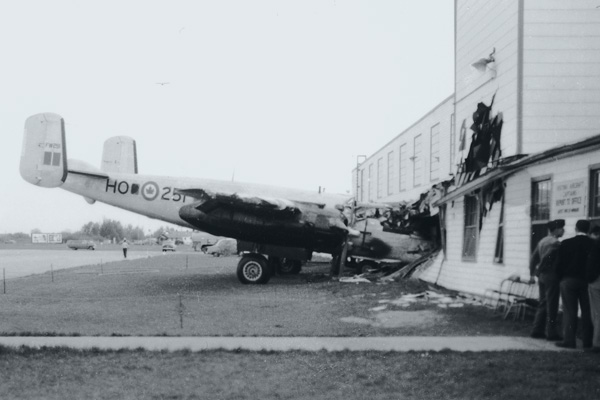
...On May 16, 1957 a hydraulic line failure resulted in no brakes when pilot F/O Terry Champion and co-pilot, the late F/O Mike Chykaliuk, attempted to park the B-25 and the aircraft crashed
into the hangar wall. Although both men were injured and hospitalized for a few days, they miraculously escaped being killed when their seats were thrown backwards. The original HO251
Mitchell, shown here, was scrapped but re-created with the restoration of Mitchell SV273 after being salvaged from a farm near Edmonton. Pilot Terry Champion spent many years with the RCAF
squadrons in Edmonton and Calgary, eventually reaching the rank of W/C, and retired as a Captain with Pacific Western Airlines. He is a long-time volunteer with the Alberta Aviation Museum.
(Alberta Aviation Museum)
Jim Gillespie, president of the 418 Squadron Association, addresses the crowd present for the roll-out on September 3, 2011, where the Mitchell was officially dedicated to the Alberta
Aviation Museum. The Museum is proudly located in a double-wide, double-long wartime hangar of the British Commonwealth Air Training Plan, adjacent to Edmonton City Centre Airport (CYXD).
(John Chalmers)
Glistening in the late summer sunshine, the restored B-25 not only celebrates the post-war activities of the RCAF, but also the 70th anniversary of the creation of 418 Squadron. (John
Chalmers)
